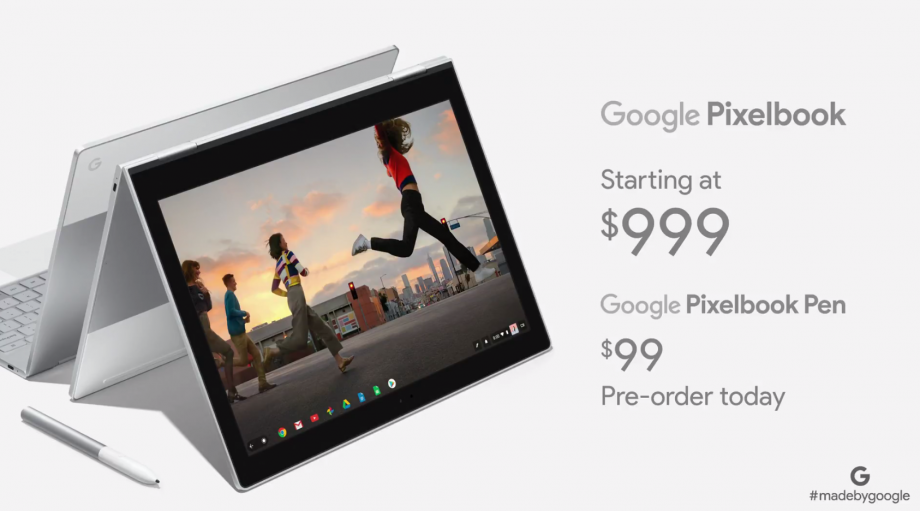Pixelbook vs Surface Pro: Which hybrid should you buy?

Microsoft arguably created the convertible laptop-tablet hybrid when it released its first Surface Pro many moons ago.
But since then we’ve seen a growing number of competitors rise. Traditionally these have been clone devices from other PC OEMs, like the Lenovo Miix 510 and Asus Transformer 3 Pro. But more recently we’ve seen big-name players with alternative ecosystems join the fray, like Apple with its shiny iPad Pro line. The Pixelbook is Google’s stab at the market, and from what we’ve seen, it’s a pretty impressive one at that.
Pixelbook vs Surface Pro: What’s the difference?
The Pixelbook and Surface Pro have completely different designs. The Surface Pro is unashamedly a tablet first. It can only be turned into a laptop replacement using a magnetically attaching Type Cover keyboard, which will set you back an extra £149.99/$129.99.
The design has its strengths and weaknesses. On the one hand it makes the Surface Pro far more portable and radically slimmer and lighter than a traditional laptop. The downside is that the lack of a physical hinge makes typing on your lap a lot less comfortable.
The Pixelbook takes an alternative approach that’s more akin to Lenovo’s Yoga series of laptops than any Surface. Specifically it works as a basic clamshell laptop, but has a nifty 360-degree hinge that lets you fold the screen all the way back, turning it into an (admittedly chunky) tablet.
The two devices are also completely different beasts when it comes to software. The Surface Pro runs using Microsoft’s full-fat Windows 10 operating system, while the Pixelbook uses Google’s cloud-focused Chrome OS.
Windows 10 is pretty standard in many offices and will work with more third-party applications than Chrome OS, which is limited to running Chrome Store web apps. But Windows is also a much more demanding operating system that will eat up more of the devices processing power and battery life.
Both devices are available with optional £100 active styluses.
Related: Best laptops
Pixelbook vs Surface Pro specs: Which has more power?
We won’t be able to sensibly confirm which device is more powerful until we’ve had a chance to more thoroughly test the Pixelbook, but both pack some pretty impressive hardware, coming with a variety of different storage, CPU and memory options. You can see a full list of the tech on offer in the table below.
| Google Pixelbook | Microsoft Surface Pro (2017) | |
|---|---|---|
| Screen | 12.3-inch | 12.3 inches (Touch) |
| Display Resolution | 2,400×1,600 | 2736 x 1824 pixels IPS |
| CPU | Intel Core i5 / i7 (7th-gen) | Intel Core m3 / i5 / i7 (7th-gen) |
| GPU | TBC | Intel HD Graphics 620 / Intel Iris Plus Graphics 640 |
| Storage | 128GB / 256GB / 512GB | 128GB / 256GB / 512GB / 1TB |
| Memory | 8GB / 16GB | 4GB / 8GB / 16GB |
| Camera | TBC | Full HD video (rear) / Full HD video (front) |
| Battery Life | TBC | 13.5 hours (standard usage) |
| OS | Chrome OS | Windows 10 |
| Dimensions | TBC | 292 x 201 x 8.5mm |
| Weight | TBC | 768 grams / 784 grams |
The only slight let down is that neither device runs using the shiny new Intel 8th Gen family of CPUs. We’ve only just started benchmarking Intel’s 8h Gen CPUs (review incoming), but from what we’ve seen they are pretty darned impressive and offer significant improvements in performance and power efficiency. Hopefully we’ll see an 8th Gen refresh of both the Pixelbook and Surface Pro soon.
Related: Best tablets
Pixelbook vs Surface Pro: Which offers better value for money?
Neither device is cheap. But when it comes to value the Surface Pro does have a slightly lower starting price than the Pixelbook.
The most basic Surface Pro configuration – 4GB RAM/128GB SSD/Core m3, Intel HD Graphics 615 – costs a modest £799.
The cheapest Pixelbook configuration – 8GB RAM, 128GB SSD, 7th Gen Intel Core i5 processor – will set you back £999/$999, by comparison. This makes it sound like the Surface Pro is the better-value option of the two. But things are actually a little more complex than that when you consider the fact you’ll have to shell out an extra £149.99/$129.99 for a Type Cover to use the Surface as a laptop and the hardware concessions you’ll have to make going for the cheapest Surface.
The memory and CPU downgrades mean the cheapest Surface will only work for basic tasks, like note taking, basic office work and web browsing. If you want to do serious photo-editing or design work, you’ll have to upgrade to the much more expensive £1249 version with an i5 CPU and 8GB of RAM.
Below you can see a full breakdown of the Pixelbook and Surface Pro’s configurations and pricing.
Pixelbook
- 8GB RAM/128GB SSD/7th Gen Intel Core i5 – £999/$999
- 8GB RAM/256GB SSD/7th Gen Intel Core i5 – £1199
- 16GB RAM/512GB NVMe/7th Gen Intel Core i7 – £1699
Surface Pro
- 4GB RAM/128GB SSD/Core m3 – £799
- 4GB RAM/128GB SSD/Core i5 – £979
- 8GB RAM/256GB SSD/7th Gen Core i5 – £1249
- 8GB RAM/256GB SSD/7th Gen Core i7 – £1549
- 16GB RAM/512GB SSD/7th Gen Core i7– £2149
- 16GB RAM/1TB SSD/7th Gen Core i7 – £2699
Interested in the new Pixelbook? Let us know on Twitter and Facebook.


